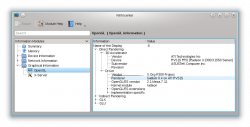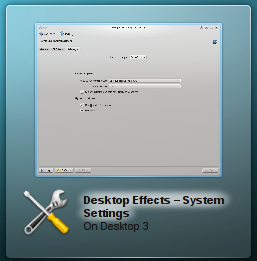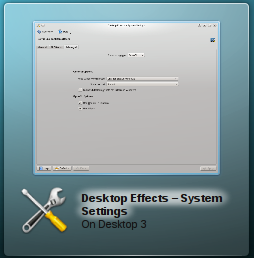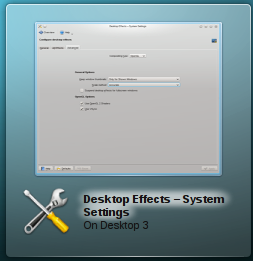Desktop Effects Performance/ro: Difference between revisions
Created page with "{{Sfat|Pentru hardware-ul modern Umbritoarele OpenGL 2 oferă o performanță mai bună decât OpenGL 1. Dezactivarea acestei opțiuni nu este o rețetă pentru cea mai bună ..." |
Created page with "Începând cu '''KWin''' versiunea 4.8 este posibil sa se utilizeze binarul contruit separat ''kwin_gles'' ca un înlocuitor pentru ''kwin''. Se comportă aproape la fel ca ex..." |
||
| Line 51: | Line 51: | ||
=== kwin_gles === | === kwin_gles === | ||
Începând cu '''KWin''' versiunea 4.8 este posibil sa se utilizeze binarul contruit separat ''kwin_gles'' ca un înlocuitor pentru ''kwin''. Se comportă aproape la fel ca executabilul ''kwin în modul OpenGL 2 cu mica diferență că utilizează ''egl'' în loc de ''glx'' ca interfața platformei native. | |||
{{Warning|This also means that if your normal ''kwin'' does not work in the OpenGL 2 mode it is unlikely that ''kwin_gles'' will.}} | {{Warning|This also means that if your normal ''kwin'' does not work in the OpenGL 2 mode it is unlikely that ''kwin_gles'' will.}} | ||
Revision as of 19:18, 4 December 2013
Performanța Efectelor de Desktop
Performanța efectelor de Desktop în Spațiile de lucru KDE Plasma este în mare determinată de interacțiunea dintre placa video (GPU) cu driverul său și Compozitorul (KWin). Compozitorul încearcă să aleagă cele mai bune setări disponibile pentru GPU-ul dumneavoastră întrebând driver-ul ce suportă hardware-ul. Uneori, spunându-i lui KWin ce suportă hardware-ul întradevăr poate îmbunătății performanța.
Selectând driverul correct
Determinând driverul utilizat
Este important să aveți driver-ul corect instalat și utilizat. Dacă nici un driver sau driver-ul greșit este utilizat efectele de Desktop vor trece pe un backend non-accelerat (XRender).
Informația despre driver-ul utilizat este disponibilă prin KInfoCenter. Click pe și studiați informațiile furnizate în modulul afișat. Informațiile relevante sunt găsite în secțiunea Driver, în special în Furnizor, Randor și Versiune OpenGL/ES. Informațiile sunt furnizate de driver și analiza lor poate fi dificilă.
 |
Dacă randatorul spune "Rasterizat din Software" atunci nu este instalat nici un driver. Pentru toate celelalte drivere verificați dacă este utilizat cel corect. |
Drivere disponibile
AMD/ATI
Pentru hardware AMD/ATI sunt disponibile două drivere: driverul proprietar fglrx sau Catalyst și driverele libere Mesa (cunoscute ca radeon, r300, r600). Cu driverul fglrx nu toate funcționalitățile sunt disponibile și performanța în general pare a fi mai bună decât cu driverele Mesa. Recomandarea este să folosiți întotdeauna drivere Mesa cu efecte de desktop. Dacă în secțiunea Versiune OpenGL/ES" găsiți "Mesa", atuncea dumneavoastră utilizați driverele libere și nu trebuie să faceți nimic.
Driverele Mesa exista în versiuni de drivere mai vechi și mai noi. Ar trebui să vă asigurați că le utilizați pe cele noi, pe care le puteți identifica prin cuvândtul "Gallium" în secțiunea Randor.
Intel
Hardwareul Intel utilizează driverele libere Mesa. Nu sunt disponibile alternative.
NVIDIA
Pentru hardwareul NVIDIA sunt disponibile două drivere: driverul proprietar NVIDIA și driverele libere Mesa (cunoscute ca nouveau). Driverele libere sunt încă intens dezvoltate și nu sunt disponibile pentru toate distribuțiile și pentru toate plăcile video. În general este recomandat să se utilizeze driverele proprietare. Utilizați driverel proprietare dacă apare NVIDIA în secțiunea Versiune OpenGL/ES.
Installing the Driver
Instalarea driverului este specific distribuției utilizate. Consultați documentația distribuției ce o utilizați despre acest subiect.
Versiune OpenGL
KWin suportă OpenGL 1.x și OpenGL 2.x. Implicit KWin utilizează funcții din OpenGL 2 dacă sunt disponibile. OpenGL 2 permite să se utilizeze mai multe efecte, dar necesită un hardware mai performant. Este important de știut că chiar dacă driverul dumneavoastră suportă doar OpenGL 1.4, spre exemplu, este posibil ca KWin să utilizeze funcții ale OpenGL 2 care sunt disponibile prin extensii ale driverului.
Puteți găsi versiunea de OpenGL furnizată de driverul dumneavoastră în secțiunea "Versiune OpenGL/ES" în KInfoCenter după cum este descris mai sus.Versiunea este definită de primele două sau trei cifre, de exemplu 2.1.
Nu este ușor să se determine dacă KWin folosește OpenGL 1 sau 2 pentru că aceasta se determină doar în momentul rulării. Cel mai bun test disponibil este utilizarea evectului Inversare care poate fi activat în . După activare ecranul ar trebui să aibă culorile inversate când se folosește scurtătura Meta + Ctrl + I. Dacă se inversează se utilizează OpenGL 2, dacă nu se întâmplă nimic, se utilizează OpenGL 1.
Este posibil ca KWin să fie forțat să utilizeze OpnGL 1 prin <menychoice> Configurări de sistem -> Efecte de birou -> fila Avansat</menuchoice> și dezactivând . Asta poate îmbunătății performanța pe hardware-ul mai vechi. În general este complet în siguranță să se utilizeze Umbritoarele OpenGL 2 dacă driverul raportează o versiune de 3.x (disponibil doat cu NVIDIA în momentul scrierii).
kwin_gles
Începând cu KWin versiunea 4.8 este posibil sa se utilizeze binarul contruit separat kwin_gles ca un înlocuitor pentru kwin. Se comportă aproape la fel ca executabilul kwin în modul OpenGL 2 cu mica diferență că utilizează egl în loc de glx ca interfața platformei native.
To test kwin_gles you just have to run kwin_gles --replace in Konsole. Since this is a rather new feature it is not as thoroughly tested as the normal kwin and feedback is always welcome. Assuming that the test succeeded and you want to use kwin_gles on a regular basis you can add an executable script to ~/.kde4/env/ that exports the KDEWM=kwin_gles environment variable.
Thumbnail Scaling
The Compositor supports different scaling methods for thumbnails as rendered in the taskbar preview or effects like Present Windows. It is tried to render the thumbnails as accurate as possible which of course requires more resources.
The scaling method can be changed in . The following settings are available:
- Crisp
- Smooth
- Accurate
The table provides an overview of how the thumbnails are rendered with the different settings.
| Overview of how the thumbnails are rendered with the different settings | |
|---|---|
| Crisp: | 
|
| Smooth: | 
|
| Accurate: | 
|
By default Accurate is used. On Intel hardware Accurate is never used and cannot be enabled unless the environment variable KWIN_FORCE_LANCZOS is set to 1.
Switching from Accurate to Smooth can significantly improve the performance of effects like Present Windows.
General Speed of Animations
Animations take some time and the length of an animations is what makes people think that this is a snappy interface or that it lags. This is a very subjective feeling and the difference between too fast and too slow can be milliseconds. It is impossible to have a perfect value for all users.
The global animation duration level can be changed through . It varies from "Extremely slow" to "Instant" which does not render any animations. By changing from "Normal" to "Fast" many users reported having a more snappy interface.
Qt Graphics System
Since 4.7 (Released July 2011) the Compositor can use the Qt graphics system raster instead of native (X11). This is only relevant for rendering the window decorations and is not related to the compositing backends (OpenGL/XRender).
Which graphics system is used depends on the distribution defaults. For the Compositor raster is recommended especially if the NVIDIA driver is used. KWin will always select the best graphics system for your chosen compositor. The following general combinations can be recommended:
- OpenGL with raster
- XRender with native
- No Compositing:
- native in case of remote connections (recommended window decoration: Laptop)
- raster if using fancy window decoration (including Oxygen and Plastik in 4.10 or later)
Window Decorations
Some Window Decorations perform animations when a window gets activated. This influences the performance of effects if during an animation the active window changes. The performance impact can be reduced by using the graphics system "raster" (see above).
The default window decoration Oxygen provides an option to disable the animations: Checkbox Enable animations. Disabling the animations can improve the performance.
All window decorations which can be downloaded through the Get New Decorations... dialog use such animations, but it is not possible to disable them. If there is an performance impact due to the theme, it is recommended to use a different one. In general the themed decorations are not optimized and provided to look good and not to be fast.
Another area of window decorations which can impact the performance are shadows. Again the default decoration Oxygen provides a setting to disable them in the same configuration dialog as described above in tab "Shadows" and the themed decorations do not provide an option to disable shadows.
Blur Effect
The Blur Effect is one of the most expensive effects provided by the Compositor. By default it gets enabled for all hardware except Intel hardware. The performance impact of the blur effect depends on the number of open and translucent windows. Especially translucent widget styles (e.g. Oxygen Translucent) and translucent window decorations (e.g. Aurorae Themes) have an impact on the performance. If such a theme is used and the performance is bad it is recommended to either change the theme or disable the Blur effect.
The performance of the Blur effect can be adjusted through . Moving the slider for strength to "Light" requires less resources while moving it towards "Strong" requires more resources. Since 4.8 (release January 2012) the intermediate rendering results can be kept (default) which improves the performance even with translucent themes.
Advanced Desktop Effects Settings
The Compositor provides some advanced settings under . Some of the settings have already been explained. This section focuses on the remaining settings. Changing these settings in general do not improve the performance but make it worse. The Compositor uses the best possible settings.
Compositing type
The Compositing type allows choice of the compositing backend, either XRender or OpenGL. By default OpenGL is used which is hardware accelerated. XRender is available even if no OpenGL driver is installed (e.g. virtual machines) and uses mostly the CPU for rendering. Many effects are not available with XRender.
Keep window thumbnails
This has hardly any influence on performance. It is an option to decide how long thumbnails are kept. Best is to not touch this setting.
Suspend desktop effects for fullscreen windows
This setting influences the performance of fullscreen windows such as games. The compositor is suspended as long as there is a fullscreen window. The disadvantage is that it causes flickering when a window appears on top of the fullscreen window (e.g. a context menu) and is too generic. As well on some distributions (e.g. Kubuntu 11.04) the Intel driver causes a crash when closing the fullscreen window.
If the compositor should be disabled while a fullscreen application such as games or video is used it is better to disable compositing either through the shortcut Alt + Shift + F12 or since 4.7 (Released July 2011) through a window specific rule for the window.
OpenGL mode
Enable direct rendering
The compositor determines by itself whether direct rendering can and has to be used. Changing this setting will most likely break functionality.
Use VSync
VSync allows you to synchronize the rendering with the screen. Unless there is good reason to change, this setting should be enabled. Even if the setting is disabled the Compositor tries to use the frame rate the screen supports and by default a frame rate of 60 Hz is used.
For multiple screens it is important to know that the rendering can only be synchronized with one screen. In case the screens have a different frame rate it might be valid to disable this option and to set a manual frame rate.


